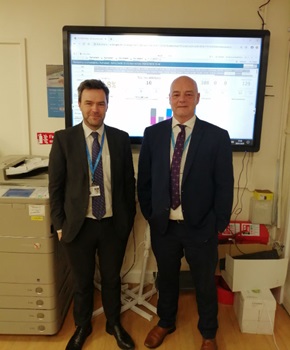How we implemented a command centre to tackle winter pressures
Lewis Thomas, general management trainee in site operations, writes about the recent implementation of a command centre at Imperial College Healthcare NHS Trust and its potential for mitigating winter pressures.
Up until recently our site operations team have depended heavily on paper-based systems to manage day-to-day operations, with reliance on phone calls and emails, and using numerous spreadsheets for capacity management to inform cross-site calls and regular divisional bed meetings.
This winter, we took a key step towards improving our flow management processes by leveraging on digital data solutions in implementing a command centre model. Using "QlikSense" software, we developed multiple data dashboards to give us an insight into the real time situation in many service areas and key points of flow on the patient journey.

The aim of the command centre is to deliver on some key operational areas, including:
- recognising changes in activity that are likely to impact on flow
- reducing emergency department overcrowding and ambulance handover times
- eliminating operating room delays and extended recovery stays
- facilitating transfers in and out of and around the hospital
- faster patient moves to the right bed in the right place at the right time
- reduced time spent on bed related issues
With further enhancements, it also has the potential to improve hospital operations in many other areas, including managing delayed transfers of care, long stay patients and non-elective admissions.
Iain Taylor, hospital director at St Mary's and the Western Eye hospitals"Individual service areas and frontline staff are already experts in the pressures that they face every day. This greater visual insight and application of data empowers service areas to make real-time data-based decisions, and gives us in site operations better oversight to provide support where and when it is most needed."
Developed as a truly collaborative initiative between site operations, business intelligence, the emergency departments, other service areas and corporate functions, we have built some core command centre dashboards which include:
- trust-wide bed state, showing occupancy and availability by ward, speciality and hospital site
- outflow, showing patients with an expected date of discharge (EDD) by ward for the coming days and providing live data on red and green patients
- emergency department, including average time in department, speciality referrals and bed allocations
- ambulance arrivals, showing predicted versus actual, ambulances waiting, and average handover time
By glancing at our five command centre screens in St Mary's Hospital's site operations office, operational managers can get all the information they need to make immediate decisions to support staff and deliver continuous quality care. The dashboards can also be accessed by any member of staff on all of our computers.
From our business intelligence team's demand prediction model, we know that this week at St Mary's Hospital will be challenging as we expect to be at peak capacity from winter pressures. Our command centre has already given us insight into how to best manage our capacity today and moving forwards by utilising clinical areas and hospital sites experiencing lower levels of demand.
Gary Cairney, deputy head of business intelligence"The collaboration between teams across our hospitals and securing the utilisation of real-time information have been key drivers to success in this project."
Looking to the future, the site operations and business intelligence teams plan to continue working closely together to improve the current command centre model. We plan to incorporate a dashboard to focus on patient quality and safety, automatically highlighting any inpatients with a rising national early warning score (NEWS) to the site nurse practitioners. Having an in-house organically developed model allows for unparalleled potential for adaptability and long-term responsiveness in our model and dashboards. The trust is also considering how to best utilise flow digitalisation models in the long term.
Our command centre plays a key role in strengthening operational performance, especially in the context of significant winter pressures. However, this innovation is not just about improving operational performance, it is about delivering on the true universal mission which brings each of us into work each morning: continually striving to improve the experience of each and every one of our patients and delivering high-quality patient-centred care.
This blog post was originally published by NHS Providers as part of their Winter Watch series. Share this post on social to join the conversation.
